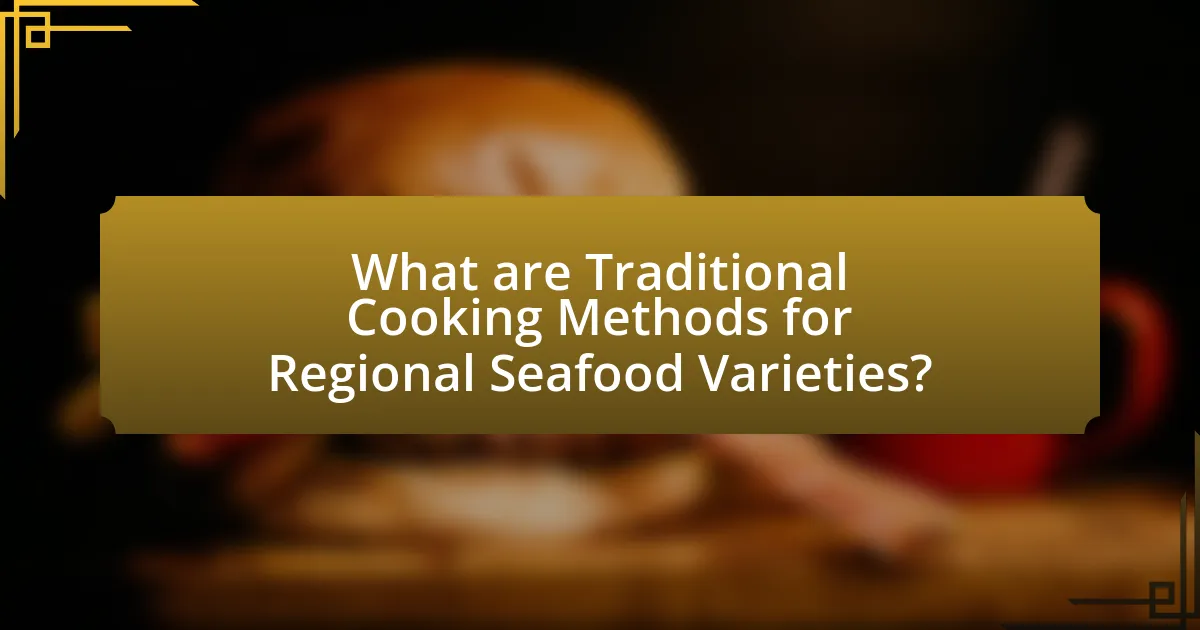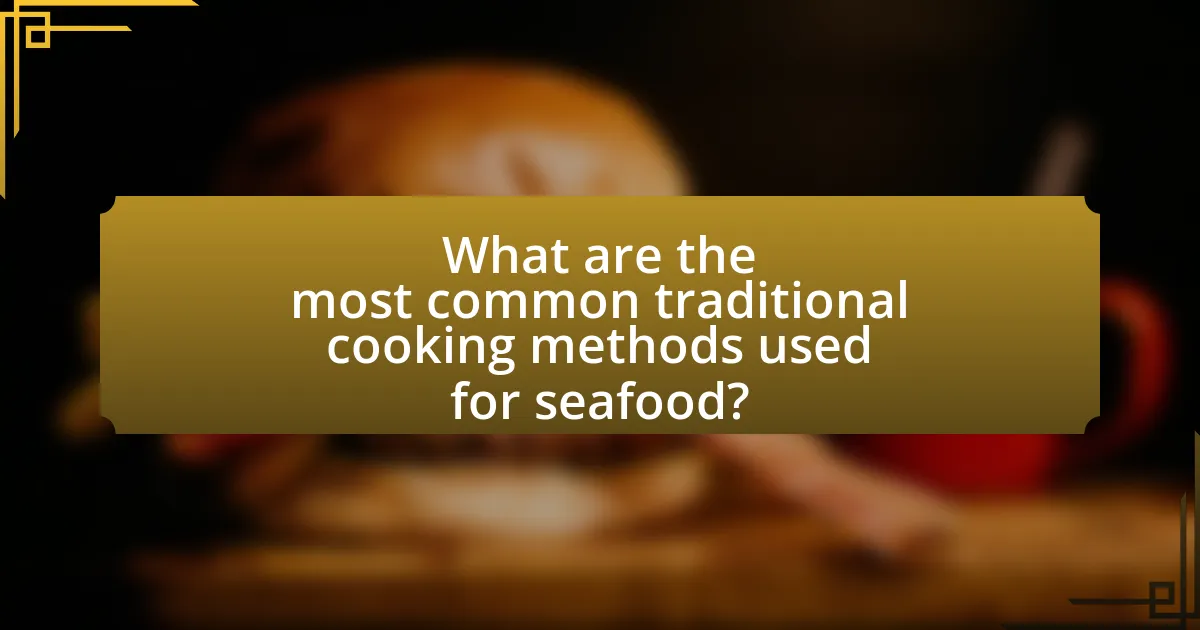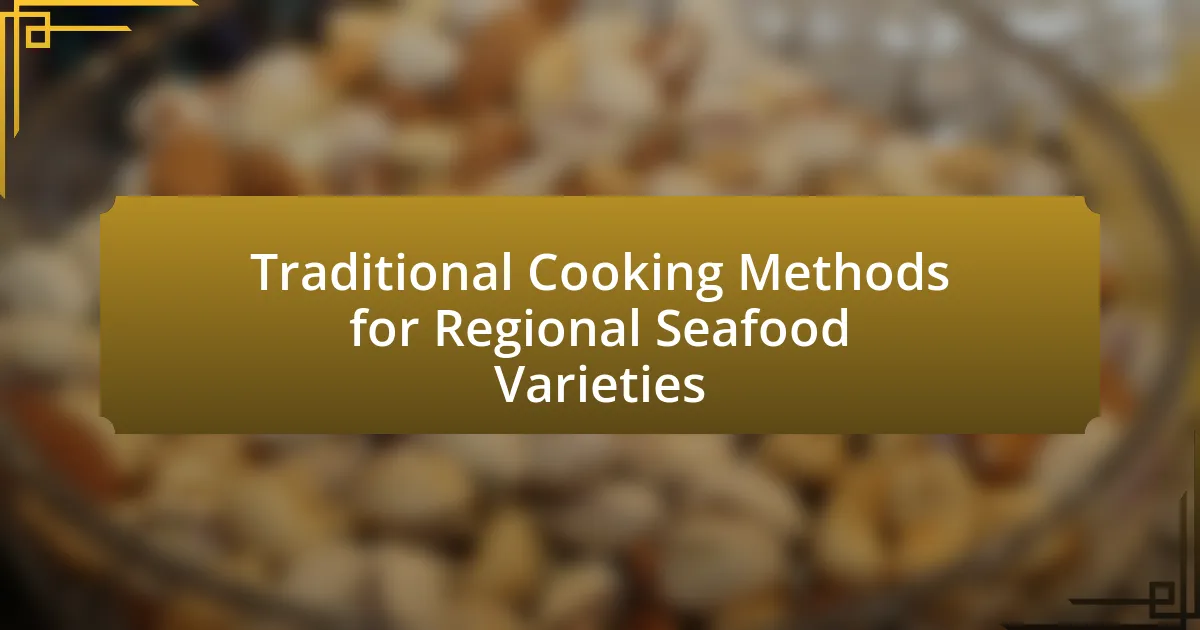Traditional cooking methods for regional seafood varieties encompass techniques such as grilling, steaming, poaching, frying, and baking, each reflecting local ingredients and culinary traditions. Coastal regions often favor grilling and steaming to enhance the natural flavors of fresh seafood, while Mediterranean cuisines utilize olive oil and herbs. Cultural influences shape these methods, dictating flavor profiles and preparation styles, with an emphasis on preserving the nutritional value and texture of seafood. The article explores how these traditional methods vary across regions, the significance of local seafood varieties, and best practices for maintaining authenticity and quality in seafood preparation.

What are Traditional Cooking Methods for Regional Seafood Varieties?
Traditional cooking methods for regional seafood varieties include grilling, steaming, poaching, and frying. Grilling is prevalent in coastal regions, where fresh fish is often marinated and cooked over open flames, enhancing its natural flavors. Steaming is commonly used in Asian cuisines, allowing the seafood to retain moisture and nutrients, often accompanied by herbs and spices for added taste. Poaching, a gentle cooking method, is favored in Mediterranean regions, where seafood is simmered in flavorful broths or wines, preserving its delicate texture. Frying, particularly deep-frying, is popular in various cultures, providing a crispy exterior while keeping the seafood tender inside. These methods reflect local ingredients and culinary traditions, showcasing the diversity of seafood preparation across different regions.
How do traditional cooking methods vary across different regions?
Traditional cooking methods vary significantly across different regions due to local ingredients, cultural practices, and historical influences. For instance, coastal regions often employ grilling and steaming techniques to prepare seafood, utilizing fresh catches like fish and shellfish, while inland areas may rely on smoking or drying methods to preserve and flavor meats and fish. In Japan, traditional sushi-making involves precise knife skills and the use of vinegared rice, reflecting the country’s emphasis on freshness and presentation. In contrast, Mediterranean regions often use olive oil and herbs in their seafood dishes, showcasing a different flavor profile and cooking style. These variations are rooted in the availability of resources, climate, and cultural traditions, which shape how communities approach food preparation and consumption.
What are the key characteristics of seafood cooking in coastal regions?
Seafood cooking in coastal regions is characterized by freshness, simplicity, and the use of local ingredients. Coastal communities often have direct access to a variety of seafood, leading to dishes that emphasize the natural flavors of the catch. Techniques such as grilling, steaming, and poaching are commonly employed, allowing the seafood to retain its moisture and delicate taste. Additionally, coastal cuisines frequently incorporate regional herbs, spices, and citrus, enhancing the overall flavor profile. The emphasis on seasonal and sustainable practices is also prevalent, reflecting a deep connection to the marine environment and local fishing traditions.
How do cultural influences shape seafood cooking techniques?
Cultural influences shape seafood cooking techniques by dictating the methods, flavors, and presentation styles used in various cuisines. For instance, in Mediterranean cultures, grilling and marinating seafood with herbs and olive oil is prevalent, reflecting the region’s agricultural practices and flavor preferences. In contrast, Asian cultures often employ steaming and stir-frying, utilizing ingredients like soy sauce and ginger, which are staples in their culinary traditions. Historical trade routes and local availability of ingredients further reinforce these techniques; for example, the use of spices in Indian seafood dishes showcases the influence of trade with other regions. Thus, cultural context not only informs the choice of cooking methods but also enhances the overall flavor profile and presentation of seafood dishes.
Why are traditional cooking methods important for seafood preparation?
Traditional cooking methods are important for seafood preparation because they enhance flavor, preserve texture, and maintain nutritional value. Techniques such as steaming, grilling, and poaching have been used for centuries, allowing the natural qualities of seafood to shine through. For instance, steaming seafood retains moisture and essential nutrients, while grilling imparts a distinct smoky flavor that complements the dish. Historical practices, such as the use of salt curing in various cultures, have also demonstrated that traditional methods can extend the shelf life of seafood while enhancing its taste. These methods not only reflect cultural heritage but also promote sustainable practices by utilizing local ingredients and minimizing waste.
What benefits do traditional methods offer in terms of flavor and texture?
Traditional cooking methods enhance flavor and texture by allowing natural ingredients to develop their full potential through slow cooking, smoking, or fermentation. These techniques often result in deeper, more complex flavors due to the Maillard reaction and caramelization that occur over time. For example, traditional smoking infuses seafood with unique flavors that cannot be replicated by modern methods. Additionally, slow cooking methods help retain moisture and improve the texture of seafood, making it more tender and palatable. Historical practices, such as curing fish with salt, not only preserve the seafood but also intensify its flavor profile, demonstrating the effectiveness of traditional methods in enhancing both taste and texture.
How do these methods preserve the nutritional value of seafood?
Traditional cooking methods, such as steaming, poaching, and grilling, preserve the nutritional value of seafood by minimizing nutrient loss during preparation. These methods typically involve lower cooking temperatures and shorter cooking times, which help retain essential vitamins and minerals, such as omega-3 fatty acids, vitamin D, and B vitamins. For instance, steaming seafood can maintain up to 90% of its nutrients, compared to boiling, which can lead to significant nutrient leaching into the cooking water. Additionally, these methods often require little to no added fats or oils, further preserving the natural nutrient profile of the seafood.

What are the most common traditional cooking methods used for seafood?
The most common traditional cooking methods used for seafood include grilling, steaming, poaching, frying, and baking. Grilling seafood enhances its natural flavors through direct heat, often used in coastal regions. Steaming retains moisture and nutrients, making it a popular method in Asian cuisines. Poaching involves gently cooking seafood in liquid, which is common in French cooking. Frying, either deep or pan-frying, creates a crispy texture and is widely used in various cultures. Baking seafood, often with herbs and spices, is a traditional method in Mediterranean cuisine. Each method has historical significance and regional variations that reflect local culinary practices.
How is grilling utilized in seafood preparation?
Grilling is utilized in seafood preparation by applying direct heat to cook various types of fish and shellfish, enhancing their natural flavors while achieving a desirable texture. This method allows for the Maillard reaction, which creates a savory crust on the surface, contributing to both taste and visual appeal. Grilling is particularly effective for seafood due to its quick cooking time, which helps maintain moisture and prevents overcooking, a common issue with delicate seafood. Additionally, grilling can incorporate marinades and seasonings that further elevate the dish, making it a popular choice in many culinary traditions around the world.
What types of seafood are best suited for grilling?
Fish, shellfish, and crustaceans are the types of seafood best suited for grilling. Fish varieties such as salmon, tuna, and swordfish are ideal due to their firm texture, which holds up well on the grill. Shellfish like shrimp and scallops also grill effectively, as they cook quickly and develop a desirable char. Crustaceans, including lobster and crab, can be grilled to enhance their natural flavors. The grilling process caramelizes the sugars in seafood, creating a rich flavor profile while maintaining moisture.
What techniques enhance the grilling process for seafood?
Techniques that enhance the grilling process for seafood include marinating, using a two-zone fire, and employing a grill basket. Marinating seafood in acidic ingredients like lemon juice or vinegar not only adds flavor but also helps to tenderize the proteins, making them more succulent when grilled. Utilizing a two-zone fire allows for direct and indirect cooking, enabling chefs to sear seafood quickly while preventing it from drying out. Additionally, a grill basket prevents delicate seafood from falling through the grates, ensuring even cooking and easier handling. These methods are supported by culinary practices that emphasize flavor enhancement and optimal cooking techniques for seafood.
What role does steaming play in cooking seafood?
Steaming plays a crucial role in cooking seafood by preserving its natural flavors and nutrients while ensuring a tender texture. This method utilizes moist heat, which prevents the seafood from drying out and maintains its delicate taste. Studies have shown that steaming seafood can retain up to 90% of its nutrients, compared to other cooking methods like boiling or frying, which can lead to nutrient loss. Additionally, steaming allows for the infusion of flavors from herbs and spices without overpowering the seafood itself, making it a preferred technique in various culinary traditions.
How does steaming affect the taste and health benefits of seafood?
Steaming enhances the taste and health benefits of seafood by preserving its natural flavors and nutrients. This cooking method minimizes the loss of moisture and essential vitamins, such as B12 and omega-3 fatty acids, which are crucial for heart health. Research indicates that steaming seafood can reduce the formation of harmful compounds compared to frying or grilling, making it a healthier option. Additionally, the gentle cooking process allows the seafood to retain its delicate texture and flavor, resulting in a more enjoyable eating experience.
What are the best practices for steaming different seafood varieties?
The best practices for steaming different seafood varieties include ensuring proper preparation, maintaining optimal cooking times, and using appropriate steaming techniques. For shellfish like clams and mussels, they should be cleaned thoroughly and steamed for about 5-7 minutes until they open, indicating they are cooked. Fish fillets should be seasoned and placed in a steamer basket lined with parchment paper to prevent sticking, typically requiring 6-10 minutes of steaming depending on thickness. For shrimp, they should be deveined and steamed for 3-5 minutes until they turn pink and opaque. These practices ensure that seafood retains its moisture and flavor while being cooked evenly.

How do regional seafood varieties influence cooking methods?
Regional seafood varieties significantly influence cooking methods by dictating preparation techniques, flavor profiles, and cooking times. For instance, the abundance of oily fish like mackerel in coastal regions leads to methods such as grilling or smoking to enhance their rich flavors, while delicate white fish like cod are often poached or steamed to preserve their texture. Additionally, local culinary traditions and available ingredients shape these methods; for example, in Mediterranean regions, seafood is frequently prepared with olive oil and herbs, reflecting the local agricultural practices. This relationship between seafood types and cooking methods is evident in various cuisines, where specific species are traditionally associated with particular cooking styles, thus reinforcing cultural identity and culinary heritage.
What are some examples of regional seafood varieties and their traditional cooking methods?
Examples of regional seafood varieties include Pacific salmon, which is traditionally grilled or smoked in North America, and Mediterranean octopus, often prepared by grilling or braising. In Southeast Asia, shrimp is commonly stir-fried or used in curries, while in Japan, tuna is frequently served as sashimi or sushi. These cooking methods reflect cultural practices and local ingredients, enhancing the flavors and textures of the seafood.
How does the availability of seafood affect cooking techniques in different regions?
The availability of seafood significantly influences cooking techniques in different regions by dictating the methods used to prepare and preserve fish and shellfish. In coastal areas with abundant seafood, such as Japan, techniques like sushi and sashimi are prevalent, emphasizing freshness and minimal cooking. Conversely, in regions with limited seafood access, such as landlocked areas, preservation methods like smoking or drying are common, as seen in the use of smoked fish in Eastern European cuisines. This regional variation is supported by historical practices, where communities adapted their cooking methods based on local seafood availability, leading to distinct culinary traditions.
What unique flavors do regional seafood varieties bring to traditional dishes?
Regional seafood varieties contribute distinct flavors to traditional dishes, enhancing their culinary profiles. For example, the briny taste of Pacific Northwest salmon contrasts with the sweet, delicate flavor of Gulf Coast shrimp, creating unique regional dishes like cedar-planked salmon or shrimp and grits. Additionally, the umami richness of Japanese uni (sea urchin) adds depth to sushi, while the firm texture of Mediterranean octopus lends itself well to grilling, resulting in dishes like octopus a la plancha. These flavor profiles are shaped by the seafood’s habitat, diet, and local cooking techniques, making each regional variety integral to its traditional cuisine.
How can one adapt traditional cooking methods for modern kitchens?
To adapt traditional cooking methods for modern kitchens, one can utilize contemporary appliances and techniques that streamline the cooking process while preserving authentic flavors. For instance, using an electric steamer can replicate the gentle steaming methods traditionally employed in various cultures, allowing for precise temperature control and reduced cooking time. Additionally, sous-vide cooking, which involves vacuum-sealing food and cooking it in a water bath at a consistent temperature, can mimic traditional slow-cooking methods, ensuring that seafood retains its moisture and flavor. These modern adaptations not only enhance efficiency but also maintain the integrity of traditional recipes, as evidenced by culinary studies that highlight the effectiveness of sous-vide in achieving desired textures and flavors in seafood dishes.
What tools and equipment are essential for traditional seafood cooking at home?
Essential tools and equipment for traditional seafood cooking at home include a sharp knife, cutting board, pot or steamer, grill or frying pan, and seafood-specific utensils like a fish spatula and seafood cracker. A sharp knife is crucial for filleting and preparing seafood, while a cutting board provides a safe surface for cutting. A pot or steamer is necessary for boiling or steaming seafood, which is a common cooking method. A grill or frying pan allows for various cooking techniques such as grilling or pan-searing. Seafood-specific utensils enhance the cooking process; for example, a fish spatula is designed to handle delicate fish fillets without breaking them, and a seafood cracker is essential for shellfish. These tools collectively facilitate the preparation and cooking of seafood, ensuring traditional methods are effectively executed.
What tips can help maintain authenticity while cooking seafood traditionally?
To maintain authenticity while cooking seafood traditionally, use fresh, locally sourced ingredients that reflect the regional flavors and techniques. Utilizing traditional cooking methods, such as steaming, grilling, or poaching, preserves the natural taste and texture of the seafood. For example, in coastal regions, recipes often incorporate local herbs and spices, which enhance the dish’s authenticity. Additionally, following traditional recipes passed down through generations ensures that the cultural significance and original flavors are retained, as seen in various culinary traditions worldwide, such as the Mediterranean or Asian cuisines.
What are the best practices for cooking seafood using traditional methods?
The best practices for cooking seafood using traditional methods include selecting fresh seafood, using appropriate cooking techniques, and ensuring proper seasoning. Fresh seafood is crucial as it affects flavor and texture; for instance, fish should have clear eyes and a mild ocean scent. Traditional cooking techniques such as grilling, steaming, and poaching preserve the seafood’s natural flavors and nutrients. For example, steaming retains moisture and enhances the delicate taste of shellfish. Proper seasoning, often with herbs, citrus, or salt, complements the seafood without overpowering it, as seen in Mediterranean cuisines that emphasize fresh ingredients. These practices are rooted in culinary traditions that prioritize quality and flavor, ensuring a delicious and authentic seafood dish.
How can one ensure the freshness and quality of seafood before cooking?
To ensure the freshness and quality of seafood before cooking, one should check for clear, bright eyes, firm flesh, and a clean, ocean-like smell. Fresh seafood typically has a mild scent, while a strong fishy odor indicates spoilage. Additionally, inspecting the gills for a vibrant red color and ensuring the skin is shiny and moist are key indicators of freshness. According to the USDA, seafood should be kept at temperatures below 40°F to maintain quality, and it is advisable to consume it within two days of purchase for optimal freshness.
What common mistakes should be avoided when using traditional cooking methods for seafood?
Common mistakes to avoid when using traditional cooking methods for seafood include overcooking, which can lead to a rubbery texture and loss of flavor. Seafood typically cooks quickly; for example, fish fillets generally require only 4 to 6 minutes per half-inch of thickness. Another mistake is not properly seasoning the seafood, as insufficient seasoning can result in bland dishes. Additionally, using the wrong cooking temperature can affect the final outcome; for instance, high heat can cause fish to dry out. Lastly, failing to account for the freshness of the seafood can lead to undesirable flavors; fresh seafood should be cooked within a day or two of purchase to ensure optimal taste and texture.

Leave a Reply